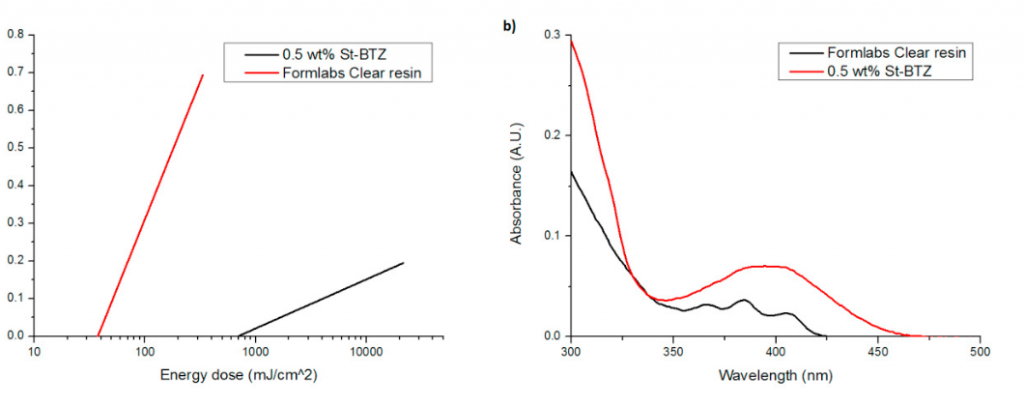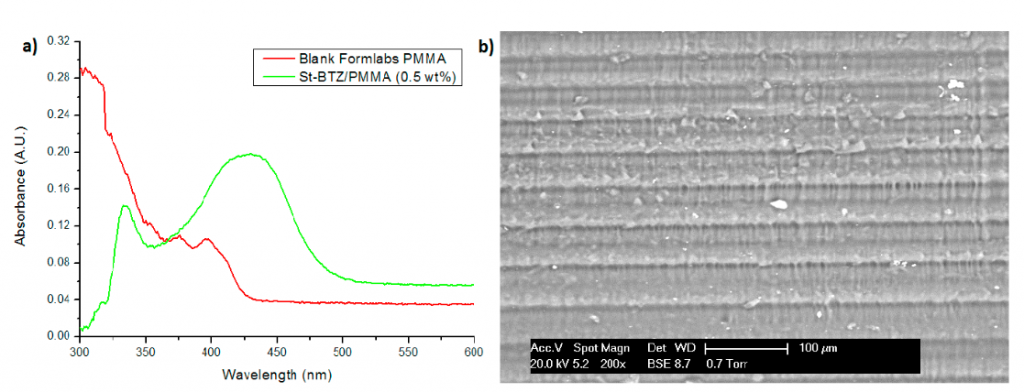“Solar energy is by far the largest resource, amongst renewable energy sources, providing our planet with more energy in one hour than all of the energy consumed by humans in an entire year.” [1]
3D printing and energy combined create a lot of excitement in the research realm, with obvious and vast potential to be tapped—all at a fingertip’s reach within the lab. In ‘Additive manufacturing of photoactive polymers for visible light harvesting,’ authors Adilet Zhakeyev, John Tobin, Huizhi Wang, Filipe Vilela, and Jin Xuan delve further into the possibilities, 3D printing photosensitizing structures for singlet oxygen generation.
In their recent work, the authors developed customized photoactive resins for SLA 3D printing of continuous flow reactors—made from photoactive polymers. They were able to demonstrate how the addition of a photoactive monomer in SLA resin can allow for more advanced 3D printing, resulting in reactors for generation under visible light irradiation.
As the team of researchers point out, being able to use solar light in chemical synthesis is a common goal among scientists.
“In recent years, it was demonstrated that conjugated porous polymers (CMPs) are well suited for light (solar energy) harvesting applications, such as photogeneration of singlet oxygen,” state the researchers. “By incorporating a photoactive material into a polymer backbone, self-quenching effect can be potentially mitigated due to reduction of the concentration of photoactive material (when compared to the CMPs).”
With the use of continuous flow microreactors, challenges in batch photochemistry can be overcome, with 3D printing presenting itself at the perfect time for eclipsing more conventional methods that are holding science back currently, including:
- Soft lithography
- Injection molding
- Etching (glass and silicon)
- Hot embossing
Traditional techniques are more limited, require more labor on the part of the user, and are more time consuming and expensive. As further research evolves in microfluidic applications, SLA has proven itself ‘promising,’ especially because it allows scientists to make complex geometries with freedom not only in design but production too.
As is common in 3D printing, however, the materials for specific projects are not yet always available. Because of this, materials science is expanding significantly as manufacturers and scientists create new materials and methods. Currently, there are just a small number of polymers available in commercial SLA materials.
“It was reported that the use of light absorbers, tailored to the light source of a SLA printer, can result in improvements in resolution of the prints and allow flow channel miniaturization, without the need for any changes in hardware, making it useful for microfluidic device fabrication,” say the authors.
CMPS can be used to improve resolution, as well as adding photocatalytic functionality, say the researchers, who focused on creating bespoke photoactive resins for expanding the use of SLA 3D printing further. They used a Form 1+ SLA 3D printer, testing the prepared 0.5 wt% St-BTZ resin and printed samples created with a layer thickness of 25 μm. They also customized the Form 1+ so that the resin tank’s tilting motion and build platform were removed. The CAD file (Creo Parametric 3.0) was created with 25 panels, ranging from 50 to 1250 microns.
“This work provided an insight into how development of bespoke photoactive resins can enable the application of SLA in fabrication of continuous flow photoreactors, where a photo-active unit is directly incorporated within the polymer matrix,” concluded the researchers. “St-BTZ was successfully incorporated into a commercially available SLA resin, which was subsequently used to fabricate a 3D photosensitizing continuous flow reactor prototype for singlet oxygen generation.”
“Results indicate that even with a small concentration of St-BTZ (0.5 wt%), SLA fabricated small scale (0.1 ml) photoactive continuous flow reactor shows activity in photosensitization of singlet oxygen synthesis under visible light irradiation (420 nm). 5.7% conversion of 2-furoic acid to 5-hydroxy-2(5H)-furanone via the photosensitization of singlet oxygen was achieved after 5 hours cycling of reaction solution. Future work will involve design and fabrication of larger volume photoreactors with intricate flow features and development of SLA resins to produce organic solvent resistant structures.”

a) working curve displaying measured panel thicknesses for a given energy exposure dose for curing Formlabs Clear resin with and without St-BTZ; b) liquid state UV/vis absorption spectra of Formlabs Clear resin with and without St-BTZ.
You may be surprised to find out how integrated 3D printing has become in areas like energy and chemistry, with researchers making use of the technology for affordable flow systems, oscillatory baffled reactors, and 3D fluidic devices. Find out more now about customized photoactive polymers here. What do you think of this news? Let us know your thoughts! Join the discussion of this and other 3D printing topics at 3DPrintBoard.com.

solid state UVvis absorption spectra of 3D printed films with and without St-BTZ; b) SEM image of a 3D printed sample containing 0.5 wt% St-BTZ.

a) CAD image of 0.1 ml photoreactor; b) image of a 3D printed 0.5 wt% St-BTZ 0.1 ml photoreactor; c) 1-NMR spectra of the mixture of 2-furoic acid irradiated at 420 nm with cycling for 5 hours (NMR conversion: ~ 5%) in D2O, peaks at 7.73, 7.31, 6.63 ppm attributed to 2-furoic acid, 7.48, 6.32 ppm attributed to the 5-hydroxy-2(5H)-furanone.
[Source / Images: Additive manufacturing of photoactive polymers for visible light harvesting]

166 Replies to “UK Researchers Customize Resins for SLA 3D Printing of Continuous Flow Microreactors”
Comments are closed.